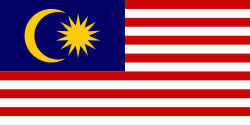Malaysian ringgit
RM
The Malaysian ringgit (plural: ringgit; symbol: RM; currency code: MYR; Malay name: Ringgit Malaysia; formerly the Malaysian dollar) is the currency of Malaysia. It is divided into 100 sen (formerly cents). The ringgit is issued by the Central Bank of Malaysia.The word ringgit is an obsolete term for "jagged" in the Malay language. The word was originally used to refer to the serrated edges. The first European coins to circulate widely in the region were Spanish "pieces of eight" or "cob", their crude appearance resembling stones, hence the word jagged. The availability and circulation of this Spanish currency were due to the Spanish controlling nearby Philippines.
An early printed source, the Dictionary of the Malayan Language from 1812 had already referred to the ringgit as a unit of money.
In modern usage, ringgit is used almost solely for the currency. Due to the common heritage of the three modern currencies, the Singapore dollar and the Brunei dollar are also called ringgit in Malay (currencies such as the US and Australian dollars are translated as dolar), although nowadays the Singapore dollar is more commonly called dolar in Malay. To differentiate between the three currencies, the Malaysian currency is referred to as Ringgit Malaysia, hence the official abbreviation and currency symbol RM. Internationally, the ISO 4217 currency code for Malaysian ringgit is MYR.
The Malay names ringgit and sen were officially adopted as the sole official names in 28 August 1975. Previously they had been known officially as dollars and cents in English and ringgit and sen in Malay, and in some parts of the country this usage continues. In the northern states of Peninsular Malaysia, denominations of 10 sen are called kupang in Malay and called pua̍t (鏺/鈸) in Penang Hokkien which is thought to be derived from the Thai word baht. e.g. 50 sen is lima kupang in Malay or 'samah' in Malay Kelantan dialect and gōo-pua̍t (五鏺/鈸) in Hokkien. The Tamil speaking communities in Malaysia use veḷḷi (வெள்ளி) meaning "silver" in Tamil to refer to ringgit, while for sen, the word kācu (காசு) is used, from which the English word "cash" is derived.
Country
-
Malaysia
Malaysia is a country in Southeast Asia. The federal constitutional monarchy consists of thirteen states and three federal territories, separated by the South China Sea into two regions: Peninsular Malaysia and Borneo's East Malaysia. Peninsular Malaysia shares a land and maritime border with Thailand and maritime borders with Singapore, Vietnam, and Indonesia. East Malaysia shares land and maritime borders with Brunei and Indonesia, and a maritime border with the Philippines and Vietnam. Kuala Lumpur is the national capital, the country's largest city, and the seat of the legislative branch of the federal government. The nearby planned capital of Putrajaya is the administrative capital, which represents the seat of both the executive branch (the Cabinet, federal ministries, and agencies) and the judicial branch of the federal government. With a population of over 32 million, Malaysia is the world's 45th-most populous country. The southernmost point of continental Eurasia is in Tanjung Piai. In the tropics, Malaysia is one of 17 megadiverse countries, home to numerous endemic species.
Malaysia has its origins in the Malay kingdoms, which, from the 18th century on, became subject to the British Empire, along with the British Straits Settlements protectorate. Peninsular Malaysia was unified as the Malayan Union in 1946. Malaya was restructured as the Federation of Malaya in 1948 and achieved independence on 31 August 1957. The independent Malaya united with the then British crown colonies of North Borneo, Sarawak, and Singapore on 16 September 1963 to become Malaysia. In August 1965, Singapore was expelled from the federation and became a separate independent country.
